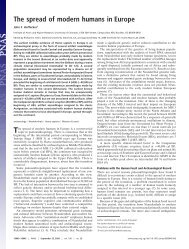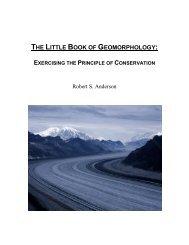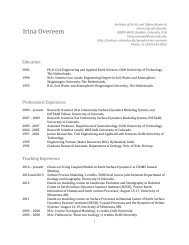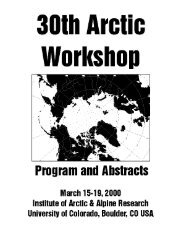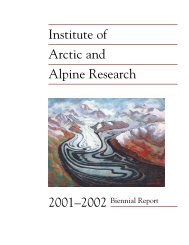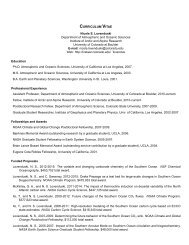Glacier Mass Balance and Regime: Data of Measurements and ...
Glacier Mass Balance and Regime: Data of Measurements and ...
Glacier Mass Balance and Regime: Data of Measurements and ...
Create successful ePaper yourself
Turn your PDF publications into a flip-book with our unique Google optimized e-Paper software.
decreasing number <strong>of</strong> measurements” (Jansson, 1999, p. 636). Thus one must be careful about acceptingrecommendations to substantially decrease the number <strong>of</strong> stations because <strong>of</strong> correlations which existbetween data at different sites.(2) It is important to keep the effort within reason. It has been shown most recently that very fewstakes are required to estimate mass balance components (results highly correlated), <strong>and</strong> these severalstakes should be placed along the elevation range <strong>of</strong> a glacier (Cogley, 1999; Fountain <strong>and</strong> Vechia,1999). WGMS proposed as the strategy for future mass balance monitoring only 2-3 stakes along themain stream <strong>of</strong> a glacier (Haeberli, 1995; Hoelzle <strong>and</strong> Trindler, 1998), which has never beenexperimentally verified.In connection with both <strong>of</strong> these requirements, two examples taken from published data may behelpful to illustrate the problem:(1) <strong>Mass</strong> balance <strong>of</strong> Vernagtferner. The mass balance has been calculated for three ice streamsemerging from the wide accumulation area. <strong>Mass</strong> balances calculated separately for these three partsshow very large differences for the 1964-96 period, such as: Brochkogel –7 m, Schwarzw<strong>and</strong> – 5 m,Taschachjoch – 11 m (data are taken from the Fig. 3 <strong>of</strong> Reinwarth <strong>and</strong> Escher-Vetter, 1999). This maybe typical for glaciers having several tributaries <strong>and</strong> local climate conditions. In such cases the number<strong>of</strong> stakes must be determined for tributaries, separately.<strong>Mass</strong> balance measurements by stakes on Variegated <strong>Glacier</strong>. This surging glacier showsenormously high difference in mass balances between neighboring stakes <strong>and</strong> changes from year-to-year(FoG, v. 5, see also Appendix, 2). The local topography is very complex, which makes spatial variabilityin snow depth distribution very high, affecting snow <strong>and</strong> ice melting during a summer. This means thatresults are poorly correlated <strong>and</strong> many stakes are needed to get accurate estimates <strong>of</strong> mass balance overthe area.To calculate the effective number <strong>of</strong> stakes (or pits), a study <strong>of</strong> the spatial distribution <strong>of</strong> thevariable is required to determine the statistical structure (isotropy <strong>and</strong> homogeneity) <strong>of</strong> a field, whichcan be described by autocorrelation functions, (G<strong>and</strong>in, 1963). This, possibly, is the most correctapproach, but it is labor extensive <strong>and</strong> time consuming.The accuracy <strong>of</strong> mass balance <strong>of</strong> entire glacier. It follows from the above that careful studiesare crucial for estimation <strong>of</strong> the real accuracy <strong>of</strong> seasonal components <strong>and</strong> annual mass balance <strong>of</strong> aglacier. We assume that these were used to get reasonably correct estimates <strong>of</strong> accuracy for severalindividual glaciers, e.g.: Storglaciären, ± 100 mm/yr (Jansson, 1999); Hintereisferner, ± 100 mm/ yr34



